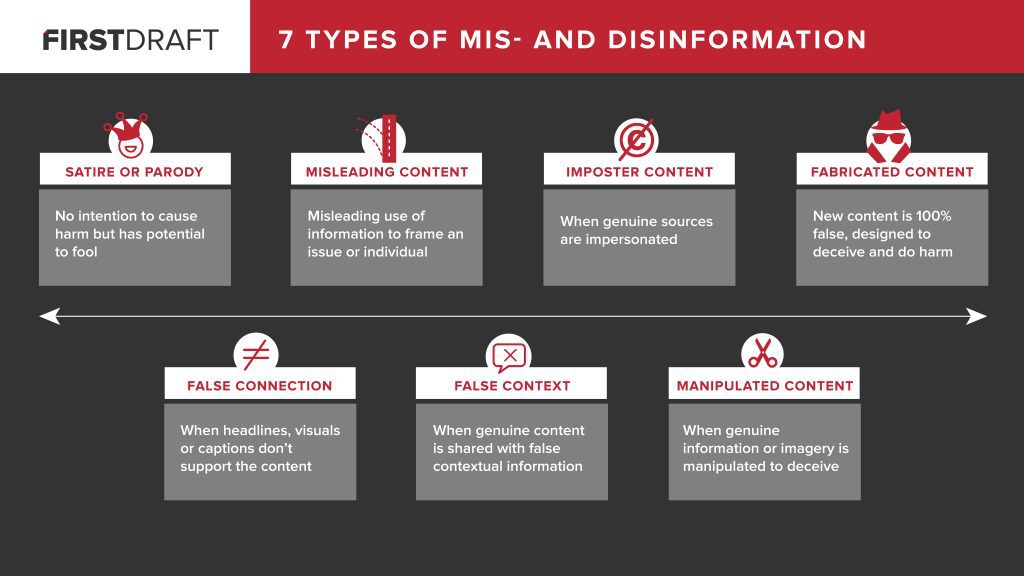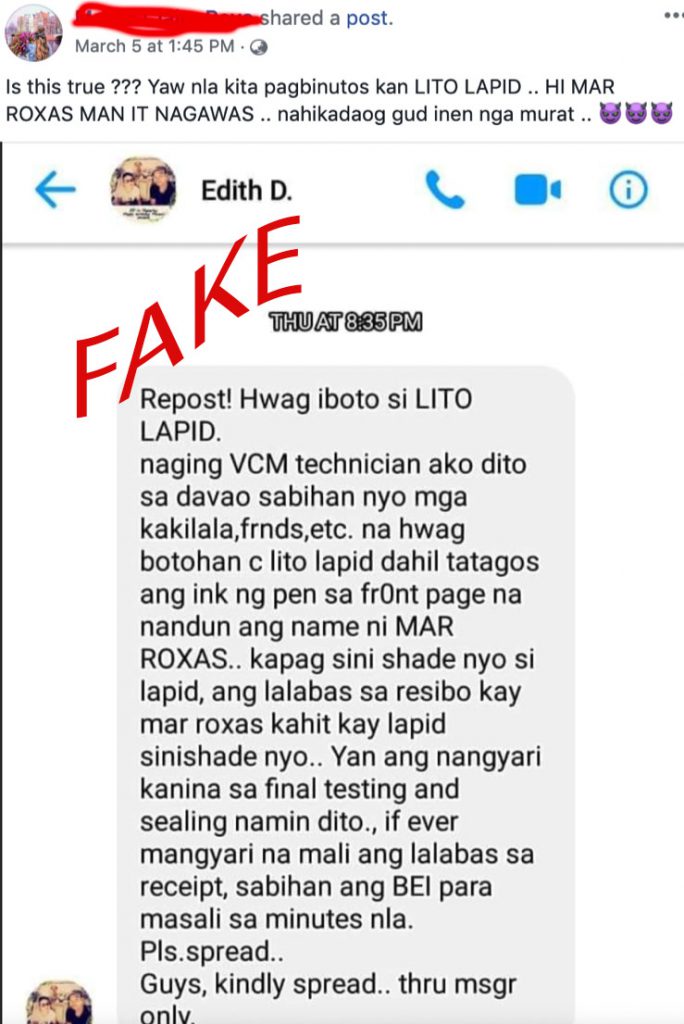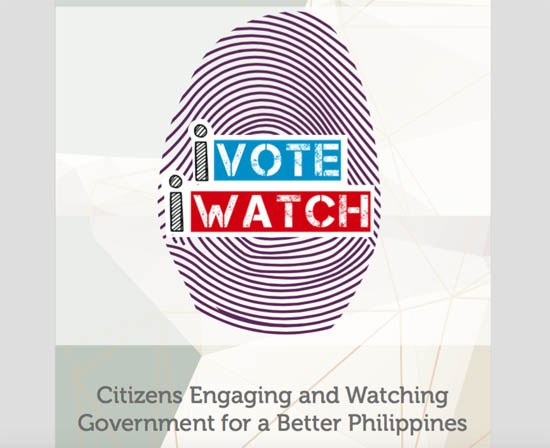7 examples of election-related misinformation & disinformation. Submit your examples too.
Submit your examples of election-related misinformation at contact @ blogwatch.tv . Read the article below to find examples.
Negative campaigning and black propaganda have been recurrent themes in BlogWatch voters education since 2010. The campaign in 2010 had, until recently, been the standard for dirty tricks and definitive proof that slime works wonders, substantiated or not. The phrase “negative campaigning” is often being done during the campaign period. In the 2010 presidential campaign, I wrote about the Villarroyo, black propaganda and negative campaigning. In my story, Bobby Reyes of Mabuhay Radio cited yellow journalism, “a biased opinion masquerading as objective fact. It involves sensationalism, distorted stories, and misleading images for the sole purpose of manipulating public opinion.” It is such an irony that yellow was the color theme of the Nonoy Aquino campaign.
Another term used to describe propaganda is disinformation. We usually consider disinformation as black propaganda because it is covert and uses false information. Disinformation means “false, incomplete, or misleading information that is passed, fed, or confirmed to a targeted individual or group”. It’s up to us to break the shackles of ignorance and apathy by educating ourselves and finding out the real score.
Take note that in 2010, less than 10% of the population had internet access. In 2019, the penetration rate is now 71% based on the recent 2019 WeAreSocial survey. Can you imagine the barrage of misinformation and disinformation in the feeds of Filipino voters?
READ: Rappler’s Fact check
READ: Vera Files Fact Check
READ: Tsek.ph, collaborative fact-checking project for the Philippines’ 2019 elections.
The purveyors of black propaganda target most of the misinformation and disinformation at the Opposition, Senatorial candidates Mar Roxas and Bam Aquino who are leading in the surveys. The lies and propaganda are out there to create doubt especially if you are an undecided voter. Another goal is also to suppress voter turnout. Deceptive or exaggerated claims targeting individual candidates even if not in the survey’s magic 12 is happening.
Let’s review some recent Facebook posts, messages, meme or blog posts based on Clare Wardle’s seven types of mis- and disinformation. Wardle explained the difference between misinformation, where information is false but the person circulating it believes it to be true, and disinformation, where the information is also false and those responsible are fully aware.
1.Satire or parody- no intention to cause harm but has potential to fool.
Know your satirical websites like the Adobo Chronicles as shown below. There is also So What’s News, Professional Heckler and possibly many more out there.
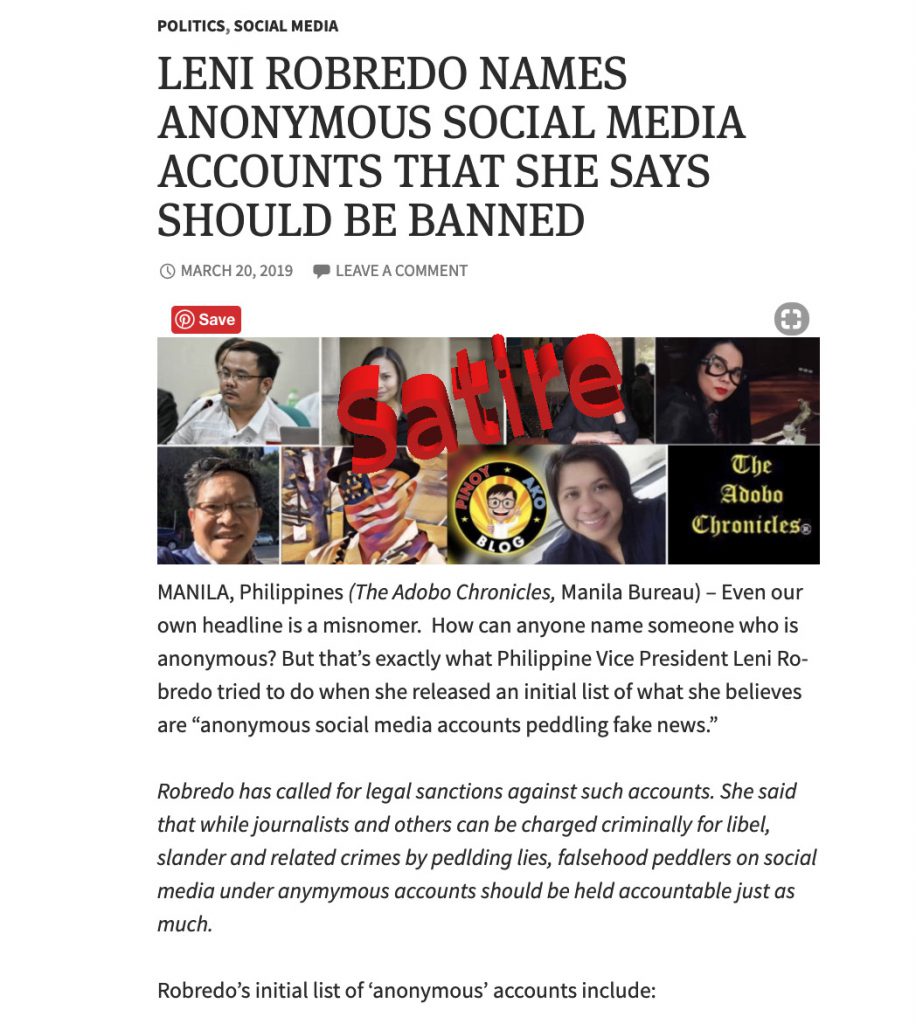
Content creators of disinformation may use satire posts and pass it off as news. It is best to check the satire websites before sharing it as news.
2. False connection- When headlines, visuals or captions don’t support the content
At first glance, the post “Robredo insists social media should be regulated” made me think that social media needs to be regulated but VP Leni Robredo had to clarify her statement. She wants to regulate ‘organized’ spread of false information online.
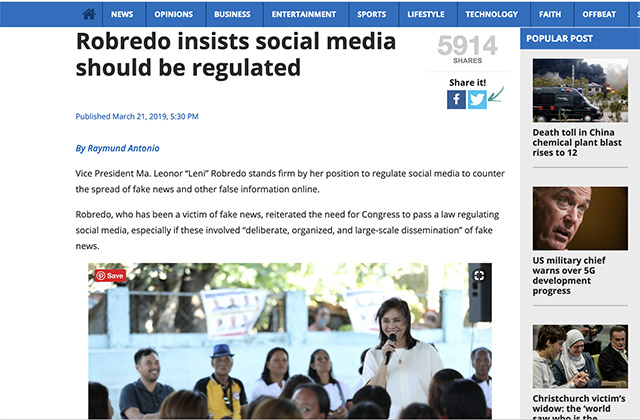
Robredo still believes social media needs to be regulated as “well-oiled machinery of fake news undermines public discourse by depriving citizens of the accurate information required to participate effectively in a democracy.” The Vice President had to clarify her statement and GMA framed the headline clearly.

3. Misleading content – Misleading use of information to frame an issue or individual.
This misleading content on midterm legislative achievements was posted at Mocha Uson’s page. Rappler identified the meme below as “misleading”. Two versions of a meme compared the “midterm legislative achievements” (laws signed in the first 3 years) of presidents Benigno Aquino III and Rodrigo Duterte.
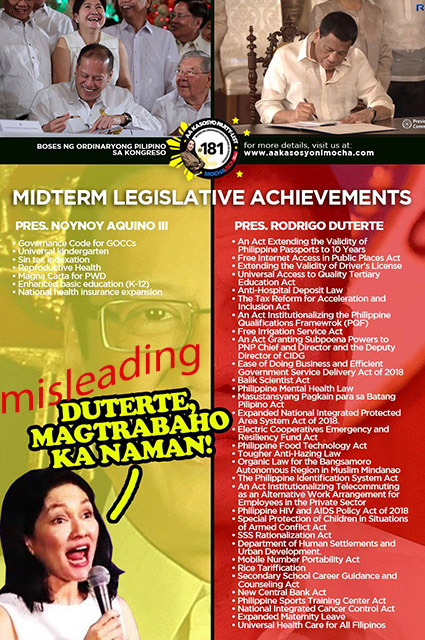
Rappler’s fact checking laid out the facts.
According to the Philippine House of Representatives website, Aquino approved a total of 460 laws from June 30, 2010 to June 30, 2013, while Duterte approved at least 314 laws (including 4 joint resolutions of Congress) from June 30, 2016 to date.
Counting only landmark laws and laws of national significance, both presidents have an almost equal number: at least 57 for Duterte and 58 for Aquino.
Another misleading post is a nine year old picture of Senatorial Candidate Mar Roxas driving a padyak or pedicab . Vera Files says this was “published, shared and re-shared in March 2018 and between March 8 and March 19 of this year.” Crowdtangle, a social media monitoring tool, was used by Vera Files to check how many pages shared this meme. At least five Facebook pages were the main sources of these posts:

4. False context- when genuine content is shared with false contextual information
Senatorial candidate Jinggoy Estrada claimed he filed hundreds of bills during his time at the Senate.

The claims need context. According to Rappler, here are the facts:
Estrada has indeed filed or co-authored over 600 bills from 2013 to 2016 alone, but only a few of these bills have been signed into law. More than 500 of them, or 83%, remained pending at the Senate committee level, while the rest remained at different stages of the legislative process.
Here is another example.

Party-list candidate Mocha Uson posted this but her photo is deceiving. Pinoyakoblog.com pointed out that the selected photo was during the setting up of the stage. Photos at the pinoyakoblog.com show there was a big attendance during the Otso Diretso rally.

5. Imposter content – When genuine sources are impersonated.
The use of imposter content is not as prevalent now compared to 2016. The recent example that I have is when mainstream media can also be victims of imposter content. The quote used by Yen Makabenta in his column “apparently came from a fake news website disguised as the website of Qatar-based media company Al Jazeera”. One really needs to look at the web address. Is it a clever knock-off? For example, abcnews.com dot co is a phony version of the actual news site abcnews.go.com and is a purveyor of fake news. It was pointed out to him but he never provided corrections.

Look at the image of the website URL which he got as a source. The legitimate url of the Aljazeera news site is https://www.aljazeera.com/

6. Manipulated Content- When genuine information or imagery is manipulated to deceive
Various memes out to discredit Bam Aquino has been appearing in Facebook. According to Vera Files , “the Bam Aquino quote is downright fake. Noynoy Aquino’s, while real, is incomplete and could therefore be taken out of context.” the “No to Liberal Party’s misleading post could have reached about 1.17 million people, with over 19,800 combined interactions on Facebook. Its top traffic generators include Facebook groups BongBong Marcos United, MOCHA USON SUPPORTERS and REAL PHILIPPINE HISTORY. No to Liberal Party’s misleading post could have reached about 1.17 million people, with over 19,800 combined interactions on Facebook. Its top traffic generators include Facebook groups BongBong Marcos United, MOCHA USON SUPPORTERS and REAL PHILIPPINE HISTORY.”
7. Fabricated content – New content is 100% false, designed to deceive and do harm
There is a warning circulating on social media claiming that votes cast for senatorial candidate Lito Lapid could be counted in favor of Mar Roxas is wrong.
The post even provided instructions to spread the post only through Facebook Messenger. However, “several netizens and Facebook pages shared the fake post between Feb. 28 and March 4 outside the messaging application in various ways:
As a screenshot of a supposed message on Facebook Messenger written in Bisaya
As a screenshot of the same message written in Filipino
As a Facebook status accompanied by Lito Lapid and Mar Roxas’ photos”
Comelec Spokesperson James Jimenez debunked the fake warning saying that Lapid and Roxas are both on the front page of the ballot. So, how will it “bleed”? Secondly, the ovals on the front and back page are unaligned. How would “bleeding through” become a problem? Lastly, final testing & sealing have not happened yet.

This fake news was posted on dutertedefenders.net (URL does not resolve anymore) which says that senatorial candidate Mar Roxas has left the Otso Diretso coalition. Rappler’s Fact Check says “Roxas has not left the Otso Diretso coalition. Coalition campaign manager Senator Kiko Pangilinan said there’s no truth to the report.”

Keep in mind Nobel Laureate Harold Pinter’s observation that:
“Politicians are interested not in truth but in power and in the maintenance of that power. To maintain that power it is essential that people remain in ignorance, that they live in ignorance of the truth.
Let us know if you find other election-related examples of misinformation or disinformation being spread in social media.
READ: Rappler’s Fact check
READ: Vera Files Fact Check
READ: Tsek.ph, collaborative fact-checking project for the Philippines’ 2019 elections.

